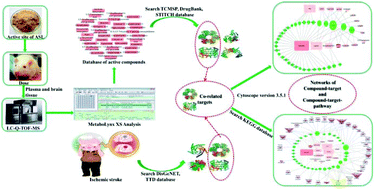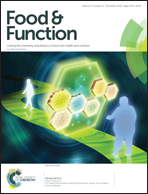Systematic studies on the in vivo substance basis and the pharmacological mechanism of Acanthopanax Senticosus Harms leaves by UPLC-Q-TOF-MS coupled with a target-network method†
Abstract
The leaves of Acanthopanax Senticosus Harms (ASL) can be used as a food ingredient and also as raw materials for making tea and wine. As a traditional Chinese medicine (TCM), ASL has demonstrated significant effects in the treatment of ischemic stroke, but the substance basis and the pharmacological mechanism of ASL are unclear. In this study, a sensitive and rapid method was constructed for the separation and identification of the absorbed prototype components and metabolites from ASL in rat plasma and brain using ultra-high-performance liquid chromatography coupled with quadrupole time-of-flight mass spectrometry (UPLC-Q-TOF-MS). A database of ASL active ingredients was established, which comprised 27 prototype ingredients and 20 metabolites from the rat plasma and 10 prototype ingredients and 7 metabolites from the rat brain. A comprehensive and effective target-network pharmacological method for tracing co-related targets and pathways between ASL and ischemic stroke was also set up. As a result, 34 targets and 30 pathways were obtained. TNF, NF-κB, IL-6, IL-1B, ICAM, and MMP-9 targets are all critical factors related to ischemic stroke, while the NF-κB signaling pathway, MAPK signaling pathway, TNF signaling pathway, and arachidonic acid metabolism play significant roles in the development of ischemic stroke. The visualized relationship between ASL and ischemic stroke was demonstrated by compound-target networks and compound-target-pathway networks, which revealed the therapeutic targets around the signaling pathways of ASL in the treatment of ischemic stroke. This research method will open a window for the mechanistic studies of TCM in the treatment of diseases.



 Please wait while we load your content...
Please wait while we load your content...